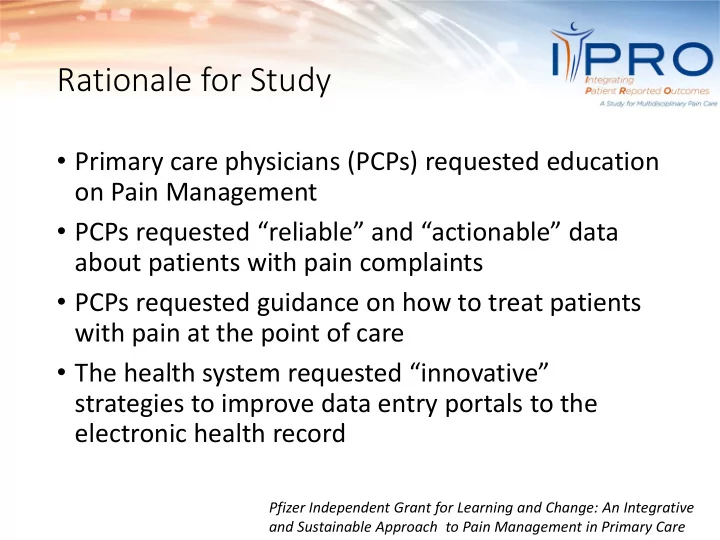

Rationale for Study • Primary care physicians (PCPs) requested education on Pain Management • PCPs requested “reliable” and “actionable” data about patients with pain complaints • PCPs requested guidance on how to treat patients with pain at the point of care • The health system requested “innovative” strategies to improve data entry portals to the electronic health record Pfizer Independent Grant for Learning and Change: An Integrative and Sustainable Approach to Pain Management in Primary Care
What we did • Developed education using electronic CME delivery model addressing the topics and format requested by the PCPs • Leveraged the NIH PROMIS surveys and the Learning Health System (CHOIR – Collaborative Health Outcomes Information Registry) to collect pain and functional outcomes and factors for risk stratification • Collected these data in a way that minimally impacted clinical workflow • Integrated the CHOIR data into the University of Florida Health Electronic Health Record (EPIC) • Provided data to the PCPs in real-time at the point of care • Provided data in a digested format • Measured patient and provider satisfaction with pain care • Characterized UF Health Family Medicine patients with pain
Provider Results • Four UF Health Family Medicine clinics recruited • 21 Family Medicine PCPs recruited • Almost no (<5%) participation in online CME tools • High (~80%) participation in person CME • NO reduction in provider satisfaction with clinic workflow • NO intervention-driven improvement in overall satisfaction with providing pain care
Patient Results • 712 UF Health Family Medicine patients enrolled (1230 clinical visits) • CHOIR system incorporated into 320 patient visits • 21% of patients were in the high risk category for Pain Catastrophizing • 8% of patients were in the high risk category on the Opioid Risk Tool • 79% of patients reported high satisfaction with care (9 or 10 out of 10) • 81% reported their provider was doing everything they could to treat their pain • 68% had confidence that their pain would be well-controlled in the future • NO intervention-driven improvement in overall satisfaction with pain clinical visits
Conclusions and Lessons Learned • Online CME • Low utilization despite PCP recognition of need and desire to learn • Possible need for innovative learning strategies that do not fit into traditional or online CME strategies including brief point of care education • In person CME • High utilization but not pragmatic, not scalable and not sustainable • Workflow • No negative impact of electronic patient reported outcomes (ePROs) • Integration of ePROs is possible without diminishing provider satisfaction • Patient Satisfaction • High patient satisfaction at baseline with no change by interventions • possible ceiling effect • Patients very accepting of ePROs and the method of data entry (tablet) • Effective use of innovative technologies with linkage to EHR • Provider Satisfaction • Unchanged by education or technology • possible need for enhancement of tools to provide clearer decision support and assistance in clinical documentation tasks
Recommend
More recommend